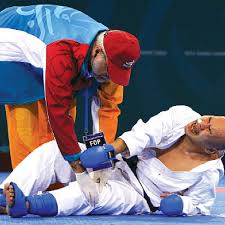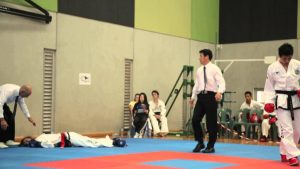Injuries in Taekwon-Do

Taekwon-Do training, by its very nature, can place the exponent in a variety of situations where injury may occur, whether it be in competition, training or during demonstrations and gradings.
Injuries and their causes can be many and varied, and hence the precautions taken to minimize injury are also many.
The types of Injury can basically be divided into 2 categories.
Cumulative Injury (chronic)
These injuries can occur at any time, and over a period of time (chronic), due to lack of warm-up or poor warm up routine, incorrect execution of technique, lack of stretching or over-stretching, forceful ballistic movements, training on inappropriate surfaces, training in extreme conditions, and so on.
These could include a range of things such as muscle strains or tears, joint sprains and ligament damage, stress fractures from over-training, shin splints and dehydration.
The most common injuries in this regard are:
- hamstring and groin strains/tears due to the degree of high kicking in particular
- sprained knees, or more serious knee ligament damage, due to the forceful rotation of spinning kicks, particularly when training on high-friction surfaces or in rubber shoes
- tendonitis in elbows, shoulders, hips and knees can occur from continual powerful practice of patterns and fundamental movements where the techniques are snapped forcefully in the air (without a target), placing strain on the tendons and joints.
Traumatic Injury (acute)
These injuries are generally caused by impact related events or traumas, whether the exponent is struck by another exponent or object, or even when the exponent strikes another person or object (e.g. breaking boards, tiles…etc).
These types of injuries can range from bruising, skin lacerations, fractured or broken bones, concussion and even internal organ damage (e.g. Eyes, punctured lungs, damaged kidneys)
The degree of injury is largely determined by the amount of force used and the nature of the site of the trauma.
Common types of injuries in this category include:
- broken nose from a forceful kick or punch to face
- fractured carpal bones from punching or striking boards, bricks and tiles
- bruising from kicks or strikes to body, ranging from mild bruising to major deep bruising, such as a cored thigh
Basic First Aid for common Taekwon-Do injuries
In the case of most soft tissue injuries and joint sprains, we adopt a couple of well known acronyms as a matter of principal.
The RICER approach is used in order to help minimize swelling to the injury. This is important, as blood tends to rush to an injured site, which can cause deep bruising (haematoma). Generally, the greater the swelling, the longer the recovery time from the injury and the more difficult it becomes to initially detect the nature of the injury:
RICER
Rest the injured part, and remove the participant from the activity which caused the injury
Ice the injured area with and ice pack, generally for 20 minutes every 2 hours for the first 24 hours and then 20 minutes every 4 hours for the next 24 hours
Compress the area with bandages to hold the icepack in place and prevent swelling.
Elevate the injured part above the level of the heart to help reduce the blood flow to the injury, again reducing swelling.
Refer for further appropriate professional treatment, if necessary for continued management
We also abide by the NO HARM principal in the treatment of soft tissue injuries and to further help minimize swelling, namely:
NO HARM
No Heat applied to the injured area for 48-72 hours, such as hot packs, deep heat creams, hot water (eg jacuzzi).
No Alcohol, which dilates the blood vessels causing greater blood flow to the injury, and also if consumed in excess, can lead to further injury of the area.
No Running or exercise, to avoid blood flow to the working muscles increasing swelling and risking further injury
No Massage for the first 48-72 hours, as massage also promotes circulation and swelling if performed initially after the injury, and direct pressure may cause greater injury, if there is deeper damage.
Other potential injuries:
Head injury / Concussion
 Concussion can occur where a student is kicked or punched to the head in sparring, or even when they fall and hit their head on the floor or wall during training.
Concussion can occur where a student is kicked or punched to the head in sparring, or even when they fall and hit their head on the floor or wall during training.
You should seek medical attention immediately if you notice the student become drowsy, irritable, disoriented, vomit, become amnesic (i.e. can’t remember clearly before the injury), experience numbness or loss of power in the limbs.
Continuing to participate with concussion, or head injury can be life threatening particularly in the case where there is even the slightest cranial bleeding. It can also affect judgment, balance and reaction time leading to further potential injury in open activities such as sparring.
Please note that the person does not need to be knocked unconscious to have concussion, if you suspect possible concussion, always refer to medical treatment and observation immediately.
Choking
Whilst not a common occurrence, the risk of a competitor choking on a mouthguard, dentures or their tongue in competition is real. It is most likely when a person may be knocked out by a kick or punch, and particularly if they hit their head upon landing on the floor.
Even in a training environment where you may have a member who is prone to fits, such as epilepsy, there is a risk of them swallowing their tongue and choking.
In the case of choking, it is necessary to dislodge the object to allow normal breathing. Under no circumstances should you slap the casualty on the back whilst in an upright position, as this may cause the object to lodge deeper.
It is recommended all instructors enrol in a First Aid course, to learn the correct ways to deal with such instances.
Nosebleed
Quite common and can be either caused by a blow to the nose, or even from training in hot conditions. It is generally not too serious, unless the nose is broken.
Have the student lean slightly forward and pinch the fleshy part of the nose just below the bone for at least 10 minutes. Meanwhile, apply cool compress to over the nose, neck and forehead. If bleeding persists, obtain medical aid
Remember in all case where bleeding occurs, the student/competitor must cease participation for their own safety and the safety of their opponent or colleague.
Always wear gloves when treating bleeding students.
Muscle camps
Often caused by over-stretching muscles, or by abnormal muscle contraction. They may also be associated with an imbalance of electrolytes due to excessive sweating.
Muscle cramps are characterized by pain, tenderness, loss of power and stiffening or spasms of the muscles. Muscles respond to rest, application of an ice pack, then subsequent gentle stretching.
Being Winded
Usually caused by a blow to the abdomen which temporarily impairs the diaphragm’s functioning. It is generally characterized by breathing difficulty, gasping and severe pain causing the person to buckle over. It is important to sit the student up and reassure them so as not to panic and hyperventilate, especially children who may not have been winded often before.
Exercise induced Asthma
Exercise induced asthma results in the person’s airways narrow making it difficult for them to breathe. There are two main factors that cause airways to become narrow: the inside lining of the airway becomes red and swollen and extra mucus is often produced or the muscles around the airways tighten.
Asthma can be a life-threatening and is characterised by shortness of breath, wheezing, anxiety and distress which can lead to panic.
It is important to be calm and reassuring.
A person who is known to be asthmatic should always carry their asthma preventative spray and /or reliever inhaler, and know how to administer it.
If the student does not have an inhaler use the first aid kit inhaler or borrow one from someone else, relievers are best given through a spacer if available
Preventative Measures to reduce risk of injury
Adequate and appropriate warm-up and cool-down
It is important to ensure that your class or student is appropriately warmed up prior to exerting themselves intensely, and that that warm-up is relevant to the activity they are about to do.
Long periods of static stretching immediately prior to high ballistic kicking does little to warm-up the student. One needs to ensure that heart rate and muscle temperature are raised in the first 5-10 minutes of class, and then gradually incorporate dynamic (not ballistic) movements, gradually increasing the range to that which will be worked during training.
It is equally important that a good cool down is performed, consisting of lower intensity exercise to help dissipate any lactic acid that has accumulated, reducing post exercise soreness, and also incorporate static stretching for flexibility gains.
Conditioning and preparation
One must ensure that they have undergone the necessary conditioning which will allow them to perform at a certain level, or a particular technique. In competition, where there is a complete mismatch in fitness levels despite similar rank and size, there is potential for serious injury once the lack of fitness kicks in and reaction time slows.
When breaking materials, it is very important that the students has conditioned the breaking tools, and gradually built up to the thickness they are attempting. Breaking is a very common cause of Taekwon-Do injuries in competitions, gradings and demonstrations.
Teach techniques which are appropriate to the students’ rank and ability only, and where possible, try to pair them up with similar ability students for sparring and self defense exercises.
Safe training surface and size
It is very important to have a training area that is safe in size and surface.
Highly polished floorboards often result in students slipping, and can be treacherous when performing high kicks. Similarly when training outdoors, or doing demonstrations, be mindful of damp surfaces or uneven areas.
The instructor must consider the floor type when teaching certain techniques, such as breakfalling, sweeping, throwing on a hard wooden or cement floor. Jumping or high-impact work on hard floors also will take its toll after a period of time, especially with heavier set students.
Where possible try to train on a jigsaw matted floor, or even on grass or sand outdoor where the climate allows.
Consider the size of the room in relationship with the size of the class and what activities you get them to do. Many clubs try to cram in as many students as they can into the smallest and cheapest hall possible.
Potential dangers occur where large numbers of people in a confined space are training, especially sparring, or training close to glass windows/walls. The instructor divide students in separate small groups at a time.
First aid and Emergency action plan
Whilst in competition there should be appropriate first aid and medically qualified persons on hand to deal with most injuries which may arise, and be able to refer to more immediate medical attention if need be.
However, in class or at a demo, it is unlikely that you would have Medical staff, therefore it is crucial that all instructors have some form of First Aid training, to deal with most minor injuries, and also that they have some sort of Emergency action plan in case there is a more serious injury.
What you should have on hand
 Whether you’re in class, at camp, a demo or anywhere you perform Taekwon-Do you should have on hand a first aid kit, ice packs, bandages and someone who is capable of applying them.
Whether you’re in class, at camp, a demo or anywhere you perform Taekwon-Do you should have on hand a first aid kit, ice packs, bandages and someone who is capable of applying them.
Within your first aid kit, include slings, bandages, swabs, rubber gloves, saline solution, an asthma spacer, tweezers (for splinters)…etc.
Keep a blanket handy for any student who may go into shock as a result of injury.
Ensure that you have a phone available to make necessary calls when an injury occurs.
It is important to have any relevant medical information about your student, tournament participant, camp attendee so that any pre-existing conditions are known, and any allergies or special conditions are identified. It would also contain relevant emergency contacts and Medicare number in case you have to rush them off to the doctor or hospital.
As stated previously, It is recommended all instructors enrol in a First Aid course, to learn the correct ways to deal with such instances.
 written by Master Michael Muleta, 8th Degree
written by Master Michael Muleta, 8th Degree
- President – United ITF Taekwon-Do Australia
- CEO – Global Fitness Institute
- Level 3 First Aid Instructor
